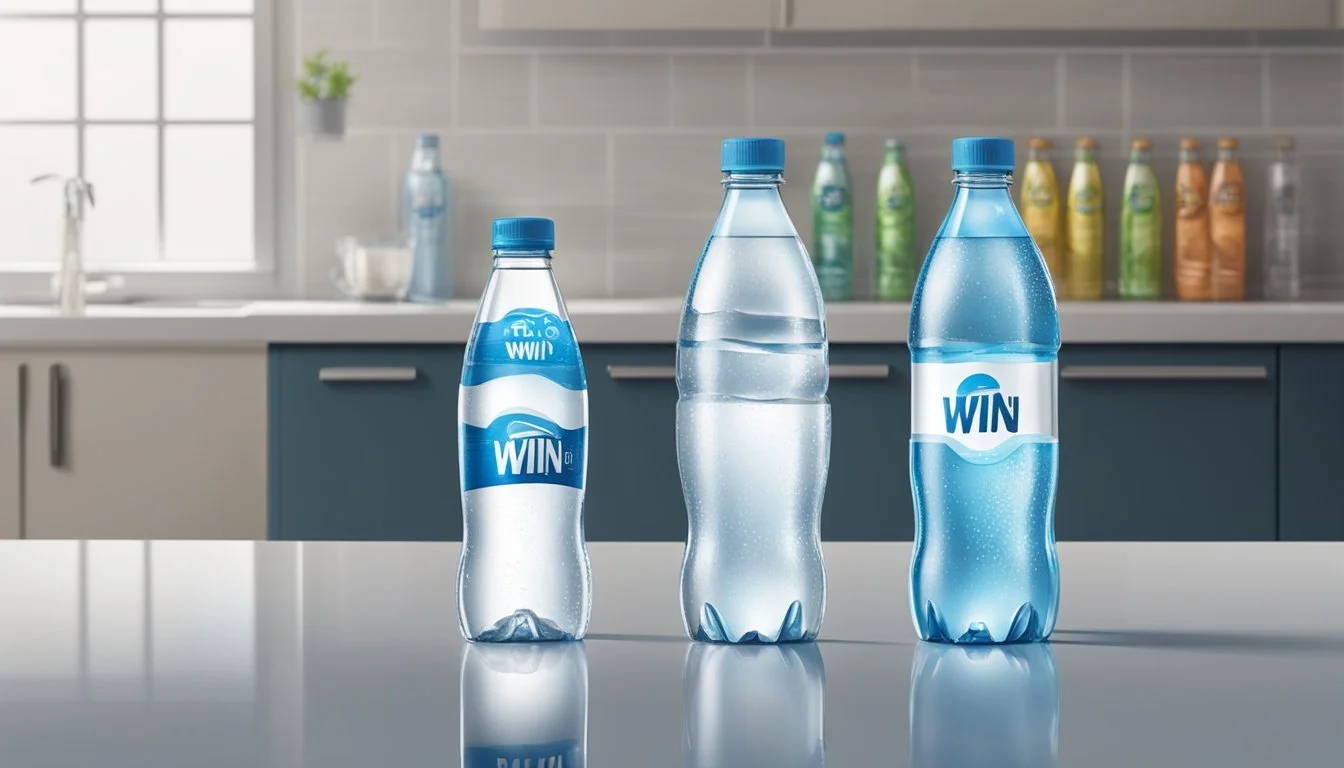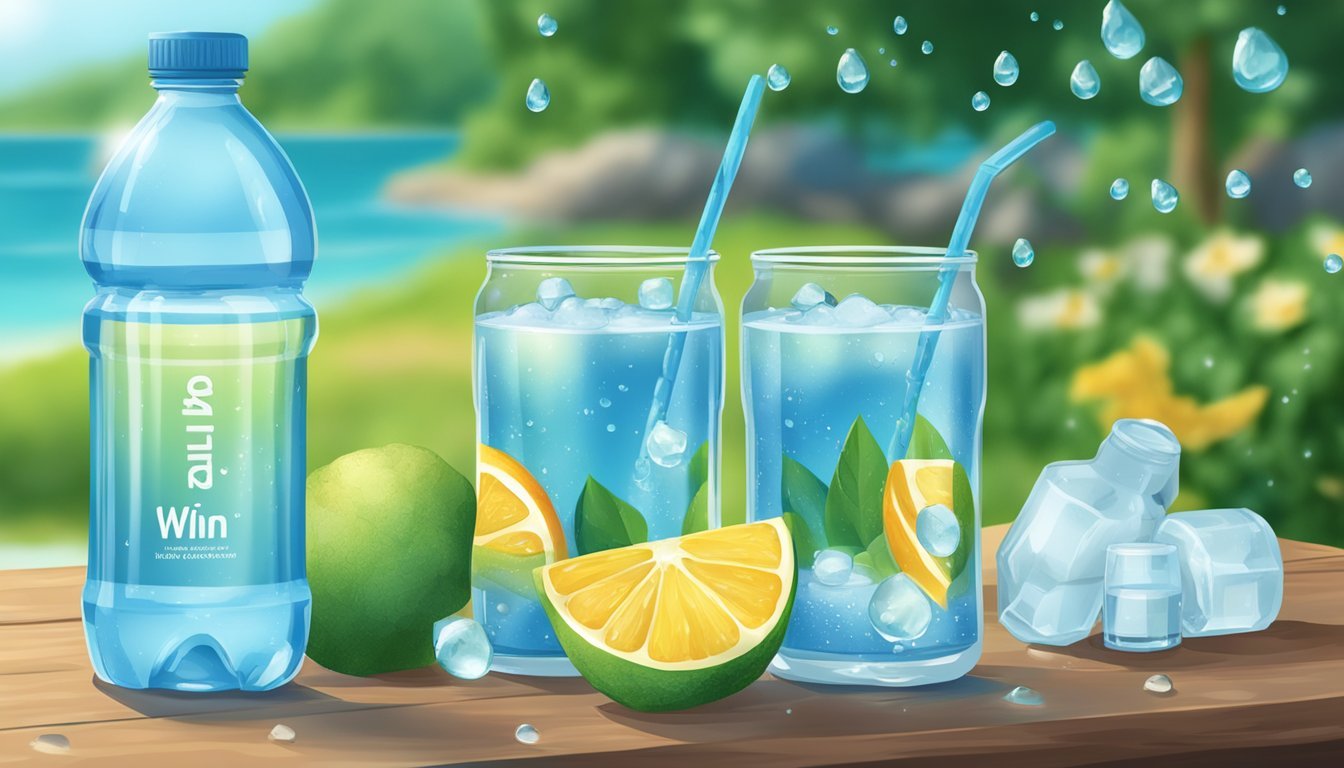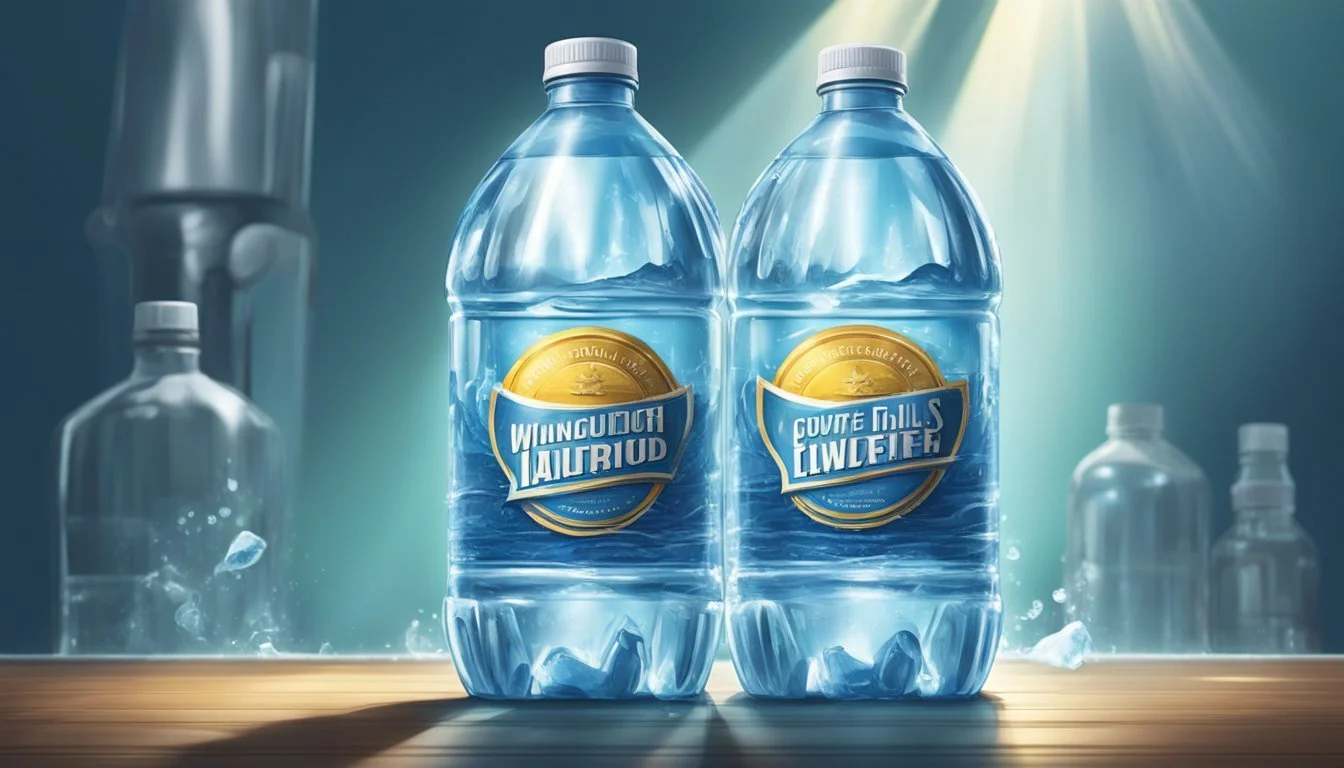Big Win vs. Action
Bottled Water Showdown Verdict
Choosing the right bottled water can seem daunting with the multitude of brands available on the market. Two prominent names that often come up in discussions are Big Win and Action. Big Win offers a crisp, clean taste that many find refreshing and pure, while Action provides balanced hydration with added minerals for a slightly enhanced flavor profile.
While both brands boast high-quality standards, the choice ultimately hinges on your personal preference for taste and the type of hydration you need. For those who prefer minimalistic and straightforward hydration, Big Win might be the ideal option. Conversely, if you're looking for a bit more with your drinking water, including added electrolytes for better hydration, Action might be your better match.
When comparing bottled water to tap water, one might consider the assured purity and convenience that these brands bring. This comparison helps illustrate the careful consideration both brands have for providing safe and readily available hydration. Whether you are a casual drinker or someone who closely monitors their hydration needs, understanding the nuances between Big Win and Action can help you make an informed choice that best fits your lifestyle.
Exploring Water Sources
Understanding the sources of bottled water is essential in determining its quality, taste, and environmental impact. The origins of water range from surface and groundwater to public water systems and natural springs.
Surface Water and Groundwater
Surface water originates from rivers, lakes, and streams, while groundwater comes from aquifers beneath the Earth's surface. Each has unique characteristics that influence the quality and taste of bottled water.
Surface water is often more susceptible to contamination due to its exposure to environmental pollutants. Water derived from these sources typically undergoes rigorous treatment to ensure potability.
Conversely, groundwater tends to be purer owing to natural filtration processes as it moves through soil and rock layers. However, groundwater can still contain dissolved minerals, which can impact taste and quality.
Public Water Systems
Public water systems often supply municipal water, which is heavily regulated to meet safety standards. Many bottled waters originate from these systems and undergo additional treatment processes, such as filtration or distillation, to enhance quality.
Municipal water sources provide a reliable and consistent supply, ensuring that bottled water meets stringent health and safety standards. The water is typically treated for contaminants to meet regulations set by agencies like the EPA.
Using municipal sources for bottling can also contribute to sustainability, as it capitalizes on existing water infrastructure without depleting natural water sources. This can reduce the environmental impact linked with sourcing and transporting water.
Natural Springs and Mineral Water
Natural springs are renowned for their pristine and refreshing water, often rich in minerals naturally filtered through geological formations. Spring water is collected directly from underground sources where it naturally flows to the surface.
Mineral water, distinguished by its specific mineral content, is also sourced from springs or wells. This type of water contains minerals such as calcium, magnesium, and potassium, contributing to its unique taste and potential health benefits.
Labeling regulations require that water labeled as "spring" or "mineral" genuinely originates from natural sources, ensuring authenticity. These waters are bottled at the source, maintaining their natural composition and purity without significant alteration.
Safety and Quality Standards
Bottled water safety and quality are highly regulated to ensure consumer health. This section will explore the key regulations, quality control measures, and environmental standards.
Safe Drinking Water Regulations
The Safe Drinking Water Act (SDWA) sets the legal standards for drinking water in the United States. The Environmental Protection Agency (EPA) is responsible for enforcing these standards. Bottled water, however, falls under the jurisdiction of the Food and Drug Administration (FDA), which enforces similar standards to protect public health.
Both agencies regulate contaminants in water, such as bacteria, heavy metals, and synthetic chemicals. Bottled water must meet or exceed these purity standards before being sold. Regular testing ensures that water quality is maintained consistently, protecting consumers from potential health risks.
Manufacturers' Quality Control
Manufacturers of bottled water implement strict quality control processes to ensure their products meet safety standards. Water treatment plants use methods like distillation, reverse osmosis, and filtration to purify water. Treated water is then tested multiple times daily to detect and remove contaminants.
The International Bottled Water Association (IBWA) recommends more frequent testing of bottled water compared to tap water. Some brands test their products up to 36 times more often than the minimum requirements, ensuring a higher level of safety. This rigorous testing involves assessing total coliform bacteria, which is a key indicator of microbial contamination.
Environmental Protection Standards
Environmental considerations are integral to the production of bottled water. Manufacturers must comply with environmental regulations to prevent pollution and ensure sustainable practices. The EPA oversees these regulations, which include maintaining clean water sources and responsibly managing waste.
A significant concern is the presence of toxic chemicals such as PFAS in bottled water. Therefore, companies are continually refining their processes to reduce or eliminate contaminants. Additionally, sustainable packaging practices are encouraged to minimize environmental impact, promoting both product safety and ecological responsibility.
Types of Bottled Water
Bottled water comes in various types, catering to different preferences and needs. Key distinctions include the source of the water and any additional processing or enhancements.
Purified vs. Natural
Purified Water is water that has been mechanically filtered or processed to remove impurities, such as through distillation, deionization, or reverse osmosis. Brands like Aquafina and Dasani offer purified water, which often starts as municipal tap water.
Natural Water includes spring water and mineral water, sourced directly from natural springs or wells. Spring water, such as Poland Spring and Zephyrhills, is collected from freshwater springs. Mineral water, like San Pellegrino and Evian, contains naturally occurring minerals without additional processing.
Enhanced Water Options
Enhanced Water includes products that have added ingredients to offer perceived health benefits.
Brands like Essentia and Core Hydration provide water with added electrolytes for better hydration. Smartwater often includes electrolytes and is vapor-distilled for purity.
Flavored and Carbonated Varieties cater to different taste preferences. Products like Nestle Pure Life and Lifewtr may offer variations with added flavors or carbonation.
Brands Overview
Several brands stand out in the bottled water market due to their unique sources and offerings:
Fiji Water is known for its artesian aquifer source and silica content.
Evian provides water from the French Alps, rich in minerals.
Icelandic Glacial offers water with a naturally high pH and low mineral content, sourced from Iceland.
Luxury Brands such as Acqua Panna and Mountain Valley deliver premium experiences, with water sourced from pristine locations and often marketed as exclusive.
More Budget-Friendly Options like Dasani and Aquafina offer widely accessible purified water options that ensure consistency and availability.
Overall, the variety allows consumers to choose products that best meet their lifestyle and taste preferences.
Health and Hydration
Understanding the health benefits and hydration aspects of both Big Win and Action bottled waters is crucial for making an informed decision. Both brands offer distinct advantages that cater to various hydration needs and health considerations.
Nutritional Value of Water
Big Win and Action bottled waters both provide essential hydration but vary in their mineral content and nutritional value. Big Win often contains calcium, sodium, and potassium at beneficial levels, which support bodily functions and help maintain electrolyte balance.
Action highlights its alkaline water with a higher pH level. Some believe this can help maintain the body's pH balance and counteract acidity. However, it's important to remember that the body generally regulates its pH effectively on its own.
Consumers may also find trace amounts of magnesium and other minerals in both brands, which can contribute to daily nutritional intake. Yet, these amounts are usually minimal and should not be solely relied upon for meeting dietary needs.
Hydration and Well-being
Hydration is fundamental for overall well-being, affecting everything from energy levels to cognitive function. Whether choosing Big Win or Action, regular consumption helps ensure optimal hydration.
Big Win's balanced mix of minerals can support muscle function and prevent cramps, especially during physical activity. The presence of sodium and potassium aids in replenishing electrolytes lost through sweat.
Action's alkaline water is marketed for its potential to hydrate more effectively due to its higher pH. Although scientific evidence is mixed, some users report feeling more refreshed and balanced when drinking alkaline water.
Both brands promote adequate water intake which is vital for maintaining health, preventing dehydration, and supporting overall bodily functions. Whether for daily activities or intense workouts, staying hydrated with either Big Win or Action can enhance well-being significantly.
Taste Evaluation
The taste of bottled water can be influenced by multiple factors, including the source of the water and the minerals contained within. Consumer taste tests provide insights into the preferences and perceptions of individuals when presented with different brands.
Factors Affecting Water Taste
Several elements impact how water tastes. Mineral content is a significant factor; waters with higher mineral content often have a more pronounced taste. Additionally, the method of purification, such as reverse osmosis or distillation, can alter the flavor profile.
Packaging materials also play a role. Bottles made from plastic might impart a slight taste over time, while glass bottles tend to keep the water's taste pure. Finally, the source of the water, whether it’s spring, distilled, or purified tap water, contributes to subtle differences in flavor.
Consumer Taste Tests
Blind taste tests are commonly used to evaluate water flavors without bias. Participants often assess aspects like freshness, purity, and any unpleasant aftertastes. A considerable number of consumers tend to prefer bottled water brands that taste neutral and clean, with no hints of plastic or metallic flavors.
According to recent taste tests, Big Win water has been described as purified and clean-tasting, similar to other reverse osmosis-purified waters. On the other hand, Action water, known for its added electrolytes, might provide a slightly enhanced taste that some consumers find appealing. These nuances in taste are critical for many when choosing their preferred bottled water brand.
Environmental Considerations
Both Big Win and Action have distinct environmental impacts that need thorough consideration. This includes the effects of production, recycling efforts, and available eco-friendly alternatives.
Impact of Bottled Water Production
The production of bottled water involves significant resource use. It requires large quantities of water and energy to produce the plastic or glass bottles. For instance, the manufacturing process emits greenhouse gases, contributing to climate change. Studies indicate that the shift to bottled water could result in the loss of biodiversity, exemplified by the 1.43 species lost annually in Barcelona if the entire population switched to bottled water.
The Environmental Working Group highlights how the decline in bottled water sales might be a sign that consumers are becoming more aware of its environmental cost. This hints at the potential for more sustainable choices if consumers are educated on the impacts.
Recycling and Waste Management
Recycling rates for plastic bottled water containers remain low, with many ending up in landfills. This contributes to significant environmental harm as plastic bottles can take hundreds of years to decompose, releasing microplastics into ecosystems. In contrast, glass bottles, although heavier and more energy-intensive to transport, are more recyclable and produce fewer microplastics.
Comparatively, reusable bottles present a more sustainable solution. By reducing the need for single-use plastics, reusable bottles minimize waste and lower the environmental footprint. This approach aligns with the goals of better waste management and reduced landfill use.
Eco-friendly Alternatives
Eco-friendly alternatives like reusable water bottles, made from stainless steel or another durable material, are becoming more popular. These alternatives are designed to replace single-use plastic bottles and limit environmental damage. Using a reusable bottle not only cuts down on plastic waste but also helps avoid the production-related emissions of bottled water.
Consumers can also consider using advanced water filtration systems at home, reducing the reliance on bottled water altogether. This method ensures access to safe drinking water while being environmentally friendly. Adopting these alternatives supports a move towards more sustainable consumption patterns and reduced environmental impact.
Economic and Practical Aspects
Choosing between Big Win and Action bottled water often boils down to the costs involved, the convenience of use, and consumer preferences. Each brand has its unique attributes that appeal to different segments of the market.
Comparing Costs
When considering price, Big Win generally offers more budget-friendly options compared to Action. Big Win's cost-effective packaging and pricing strategies make it an attractive choice for consumers seeking an affordable option. In contrast, Action, positioned as a premium brand, tends to be more expensive.
Big Win's lower costs extend across various packaging sizes, providing ample choice for different needs. Action, despite its higher price point, justifies it through perceived quality and brand prestige. Consumers might choose Action due to its association with higher standards and reliability.
Convenience Factors
Convenience plays a significant role in determining bottled water preferences. Big Win emphasizes accessibility and affordability, making it a go-to for many. Its widespread availability in stores ensures that consumers can easily purchase it during routine shopping.
Action, while also convenient, might be found in more selective retail spaces, resonating more with niche markets. Its packaging often includes more durable and aesthetically pleasing bottles, catering to those who prioritize style and convenience during travel or workouts.
Both brands offer sizes ranging from small, portable bottles to larger, family-sized options, yet the emphasis Big Win places on everyday practicality gives it an edge for many users. Action's convenience links closely with its premium positioning, offering sleek designs that appeal to specific consumer segments.
Consumer Preferences
Consumer preferences highlight distinct patterns between choosing Big Win and Action. Many consumers opt for Big Win due to its cost-efficiency and practicality. This choice aligns with those who prioritize functionality and savings without sacrificing hydration needs.
On the other hand, bottled water consumption trends suggest a growing segment that prefers Action due to its perceived superior quality. Consumers attracted to premium products, even at higher costs, often cite taste and purity as key factors. This preference underscores the brand's targeted appeal to health-conscious and quality-focused individuals.
Ultimately, the variety and choice offered by both brands cater to diverse markets, allowing consumers to select based on their specific economic and practical considerations.
The Bottled Water Industry
The bottled water industry is vast, dynamic, and continues to grow exponentially. With a variety of brands vying for consumer attention, it is crucial to understand the major players, how they market their products, and the regulatory environment they navigate.
Leading Bottled Water Brands
Bottled water is dominated by well-known brands such as Fiji Water, Evian, and Arrowhead. These brands have carved out significant market shares due to their reputation for quality and purity.
Fiji Water is renowned for its natural artesian source in Fiji, while Evian is prized for its spring source in the French Alps. Arrowhead markets itself as mountain spring water from various sources in the western United States. These brands leverage unique selling points to distinguish themselves in a competitive market.
Marketing and Consumer Perception
Marketing plays a pivotal role in shaping consumer perceptions of bottled water. Brands like Fiji Water and Evian use imagery of pristine natural sources to foster a perception of superior quality and purity.
Advertising often emphasizes the health benefits of their water, appealing to consumers' concerns about safe drinking water.
Despite the high price tag of premium brands, strong marketing convinces many consumers that these products are worth it compared to tap water or budget bottled options. Visual branding, endorsements, and advertising campaigns are tools used by manufacturers to build trust and loyalty among consumers.
Regulation and Trust
Contrary to popular belief, bottled water is not always subject to more stringent regulations than tap water. In the United States, the FDA regulates bottled water, while the EPA oversees tap water.
A study by Orb Media found microplastic particles in 93% of sampled bottled waters, raising concerns about safety and quality. This regulation gap can lead to mistrust, as many consumers assume bottled water is guaranteed to be safer.
However, strong brand loyalty and effective marketing have built consumer trust in leading brands despite these concerns. Consumers often rely on branding and perceived quality when making purchasing decisions, highlighting the importance of transparency and rigorous testing in the industry.
Alternatives to Bottled Water
One can choose several methods to access safe and clean water without resorting to bottled alternatives. Two popular options include home filtration systems and utilizing public drinking water supplies.
Home Filtration Systems
Home filtration systems offer a convenient way to ensure tap water is safe to drink. Carbon filters, commonly found in pitchers and faucet attachments, improve taste and reduce chlorine. Reverse osmosis systems are more advanced, removing a wider range of contaminants including heavy metals and microbes.
Using a reusable bottle with a built-in filter adds portability to these solutions, making it easy to have filtered water on the go. Some filters can also add minerals back into the water for added health benefits, mimicking the taste of mineralized or alkaline water.
Public Drinking Water Supplies
Public drinking water supplies are often highly regulated and tested for safety. Many cities invest in advanced treatment processes to ensure tap water quality. Regular filtering can still be applied at home to address any residual concerns.
Public water fountains and refill stations, increasingly found in urban areas, encourage the use of reusable bottles. These options not only reduce plastic waste but also provide easy access to hydration throughout the day. Some facilities even offer flavored water stations, making the switch from bottled water more enticing.







